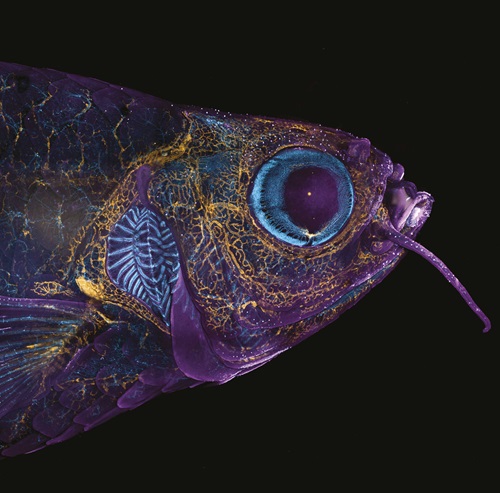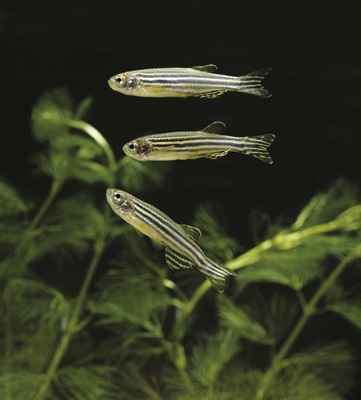A Clear Advantage
Once these researchers found zebrafish, no mammal model could measure up.
By Jenna Schnuer

Peer into any home aquarium and there’s a good chance some zebrafish will dart by, easy to identify thanks to their namesake stripes. But that beginner-friendly aquarium species has, since the early 1960s, also been a favorite fish to watch for some researchers.
Turns out that zebrafish (Danio rerio), originally found in freshwater in India, have a surprising amount in common with humans. About 70% of the 26,000 protein-coding genes identified in the fish have at least one obvious orthologue—genes that evolved from a common ancestral gene—to humans, according to a 2013 paper in Nature.
That’s not all. Though humans walked away with legs and arms versus the fins and other water-worthy features of zebrafish, both vertebrates claim ownership of everything from eyes to many internal organs and cartilage. Teeth, too. And, like with other vertebrates, zebrafish nervous systems evolved to help the animals avoid predators while on the hunt for food, shelter and mating partners.
The overlap makes zebrafish ideal subjects for researchers hoping to figure out animal behavior and developmental and other biological processes, as well as the reasons some diseases take hold.
One feature zebrafish definitely don’t share with humans that makes them far better research subjects than their mammalian counterparts: The larvae are transparent. As imaging techniques have improved, the transparency has proved a greater and greater benefit. Take that, mouse model.
“Within months, no one in my lab, when they saw what we were able to do [with zebrafish], wanted to work on goldfish anymore.”
Joseph Fetcho, PhD
“Clinical researchers always scratch their heads when you tell them that something of relevance to human biology will come out of a fish or a fly,” says Josephine Briggs, MD, editor-in-chief of the Journal of the American Society of Nephrology and director emeritus of the National Center for Complementary and Integrative Health at the National Institutes of Health. “I think learning our fundamental biological processes, a lot of which are shared between all of us and other eukaryotes, is very interesting and really quite productive.”
Full System Access
The ability to see a whole system and watch it develop is key for many zebrafish researchers. “I’ve always had big questions about the nervous system. Having a model that I can have genetic access to, as well as treat pharmacologically, makes it very accessible,” says Sarah Kucenas, PhD, professor of biology, cell biology and neuroscience at the University of Virginia in Charlottesville; co-director of the school’s Brain Institute; and director of the program in fundamental neuroscience. “And then maybe most importantly, which is why many of us use zebrafish, are the imaging capabilities. These fish are see-through, and as someone who wants to watch biology, it’s the perfect system to be able to do that.”
Joseph Fetcho, PhD, a snake model guy, dove into working with a fish model by the early 2000s. But those fish—goldfish—weren’t, to put it mildly, helping him move his research forward with any gusto. A researcher at Stony Brook University in New York at the time, Fetcho is now a Cornell University professor of neurobiology and behavior, the Dr. David & Dorothy Joslovitz Merksamer Professor of Biological Sciences, and the director of Cornell Neurotech-Arts and Sciences.
“I was getting sick of recording one neuron at a time,” he says. Fetcho knew about zebrafish and their potential. During a conversation with another Stony Brook postdoc, Donald O’Malley, PhD, Fetcho mentioned a recent paper that talked about labeling neurons with calcium dyes coupled to dextrans. Nerves damaged by the dye carried them back to the cell bodies of the neurons and labeled them, “and then you just have to look at them and watch them light up,” Fetcho says.
That all depended, of course, on having the right imaging equipment. Fetcho suggested they put the “latest greatest technology” in the lab O’Malley worked in to use, a commercial confocal microscope. The combination of the imaging equipment, the dye and zebrafish would allow them to do something nobody had ever done before: “watch real activity inside of the vertebrae animal,” Fetcho says.
One other issue—Fetcho didn’t have any zebrafish. But this was in the days before the animal care rules. “I literally went to the pet store and bought zebrafish and marbles to put in the tank so the eggs would drop and be protected,” he says. “We had eggs the next day.”
He adds: “Within months, no one in my lab when they saw what we were able to do, wanted to work on goldfish anymore.”
That zeal becomes endemic once researchers see what zebrafish can do. The model still isn’t the go-to for most labs, but it’s growing. In the early 2000s when Kucenas was a graduate student, “fish was really just becoming a really popular model.”
“While we were sequencing the genome, and we were able to do pharmacology, CRISPR wasn’t a thing then, so it was very difficult to make mutants. We had to do everything with mutagenesis,” Kucenas says.
Zebrafish zap that challenge and even the mouse model people are catching on. “Technologies kept developing both in zebrafish, but also more broadly in biomedical sciences, and every time a discovery benefits biomedical sciences and is working in mice now, people are rapidly turning it into a tool that’s used in fish,” Kucenas says.
Building the Brain
For some researchers, the zebrafish model provides a way to start from the very beginning. A developmental neuroscientist, Kucenas wants to know “how you build a brain. How do you get a nervous system that functions and allows an organism to learn and have memories?”
What has to happen, she asks, “for the cells to be in the right place at the right time to make the right connections?”
At the Kucenas lab, they’re studying all things glia to chase the biology. They label the glia with different colors and “just watch.”
Fun Fishy Facts
Though zebrafish may top out at 4 centimeters, the diminutive swimmers continue to pull in a whale’s worth of attention from an ever-growing fanbase of aquarium enthusiasts and scientists alike. The love is well-deserved. Zebrafish are fascinating little pack animals who prefer sticking together. Here are a few facts about the species:
- Long before any zebrafish had been dropped into a fish tank in a lab or a fourth grader’s bedroom, the animals swam in the Ganges River in Eastern India as well as silty pools and rice paddies near streams.
- Zebrafish live on average for three years but can hang around for more than five years in a lab setting.
- Like humans, the fish can develop a spinal curvature as they age. (They do not, however, use walkers or canes.)
- When the fin of an adult zebrafish is injured, they can grow a replacement. Same goes for regeneration of the tail—and it takes just two to four weeks.
- Zebrafish pairs produce around 300 eggs per week. The larvae hatch two days after fertilization and, within three months, have grown into fully mature fish ready to do some breeding of their own.
- Scientists aren’t the only people futzing around with zebrafish genetics. A company called GloFish genetically modified zebrafish (and other species) to create fish with eye-popping stripes, including “sunburst orange,” “galactic pink” and “electric green.”
- Last summer, zebrafish joined a long list of animals that have traveled to space as part of scientific research. The Tiangong space station is now home to a school of zebrafish that are being used to study bone loss in astronauts and interactions between fish and microorganisms in a closed ecosystem.
“There’s so many assumptions made,” she says, “because nobody’s really been able to watch the development of the nervous system. There’s just these assumptions.” But her lab work keeps serving up biology that “goes against the textbooks.”
As a postdoctoral fellow, Kucenas studied spinal cord and motor nerve development. The textbook knowledge about the nerves held that glial cells didn’t cross between the central nervous system and peripheral nervous system.
“What I discovered using zebrafish is that that’s totally wrong,” she says. “They migrate back and forth all the time. It was this ah-ha moment.”
Her first paper on this discovery was published in 2008. It took three years of “seeing what we were seeing and then spending all that time making sure we were right” about this new biology.
Since that time, she’s encouraged other researchers in her lab to “just look, just watch.” Along the way, they’ve discovered new cell types and new behaviors for cells.
“It’s changing the way people think about how you build a brain. I mean, obviously, we knew it was complex but whoa, there’s so much more than we even imagined, and the fish allow us to just watch,” Kucenas says.
Moving Imaging Forward
Fetcho’s lab also looks at the brain. His current focus, which he expects to take him through to retirement in about four years, is on finding the path to image the zebrafish brain “at any time from egg to grave.” It’s the latter part of the fishes’ lifespan that’s been the challenge at this point. As zebrafish age, their skulls become opaque, shutting out the ease of imaging during the larval stage.
 But the imaging side of the science has caught up, which will allow Fetcho to capture what’s going on inside the intact skull of a zebrafish. The new technology, developed at Cornell, is long wavelength three-photon microscopy that provides the
“deepest you can image into the brain of any animal,” he explains.
But the imaging side of the science has caught up, which will allow Fetcho to capture what’s going on inside the intact skull of a zebrafish. The new technology, developed at Cornell, is long wavelength three-photon microscopy that provides the
“deepest you can image into the brain of any animal,” he explains.
“Because then you can do development,” Fetcho says. “You can do plasticity and learning, and you could do degradation and neurological disorders and stuff through the entire life of vertebrae animals.”
Peace, Love and Zebrafish
In some areas, researchers aren’t really known for collaboration outside their lab. That is, until you get to the zebrafish community. “People share lines or tools before they’ve even published,” Kucenas says. “It’s part of our ethos.”
The community’s characteristics stem from the early days of zebrafish research at the University of Oregon. Called the “founding father of zebrafish research” by the International Zebrafish Society, Oregon’s George Streisinger, PhD, started bringing researchers together informally in the 1960s to share his zebrafish knowledge from the get-go.
Other Oregon researchers—including Judith Eisen, PhD; Monte Westerfield, PhD; and Charles Kimmel, PhD—“were incredibly generous, and that set the tone,” Fetcho says. “They taught people how to do anything they wanted to learn. It’s not true in a lot of animal communities.”
The sharing hasn’t stopped. In January 2024, the International Zebrafish Society will host the 10th Strategic Conference of Zebrafish Investigators and, in August 2024, the 18th International Zebrafish Conference.
Oregon remains the center of the zebrafish model world thanks to ongoing research and its hosting of the Zebrafish Information Network. Showcasing the zeal factor: The university’s weekly meeting of labs that use the model is called the Zebrafish Groupie.
This article was originally published in the January 2024 issue of The Physiologist Magazine. Copyright © 2024 by the American Physiological Society.
“Clinical researchers always scratch their heads when you tell them that something of relevance to human biology will come out of a fish or a fly.”
Josephine Briggs, MD
The Physiologist Magazine
Read the Latest Issue
Don’t miss out on the latest topics in science and research.
View the Issue Archive
Catch up on all the issues of The Physiologist Magazine.
Contact Us
For questions, comments or to share your story ideas, email us or call 301.634.7314.


